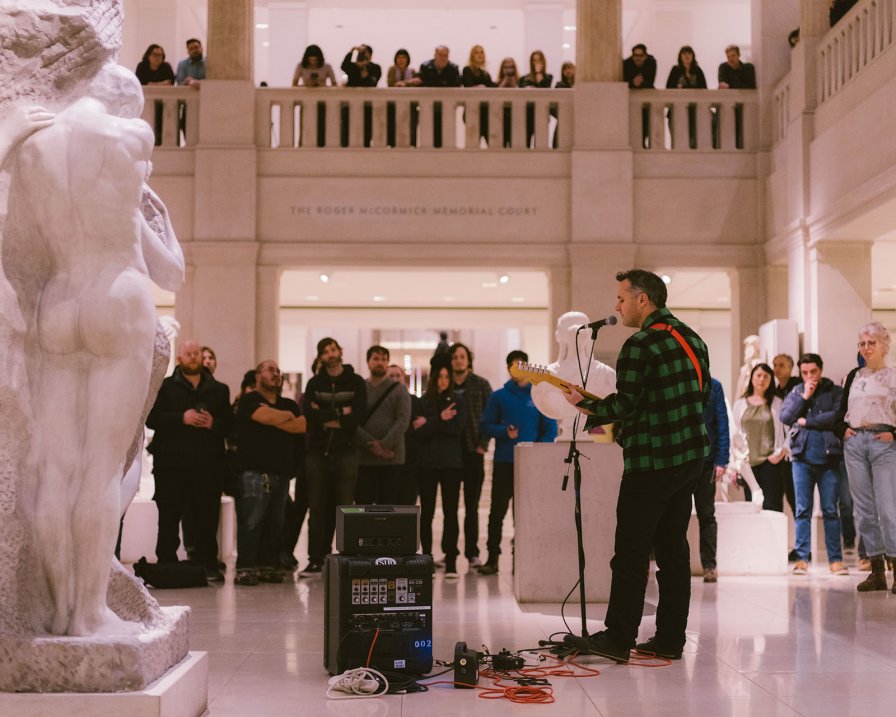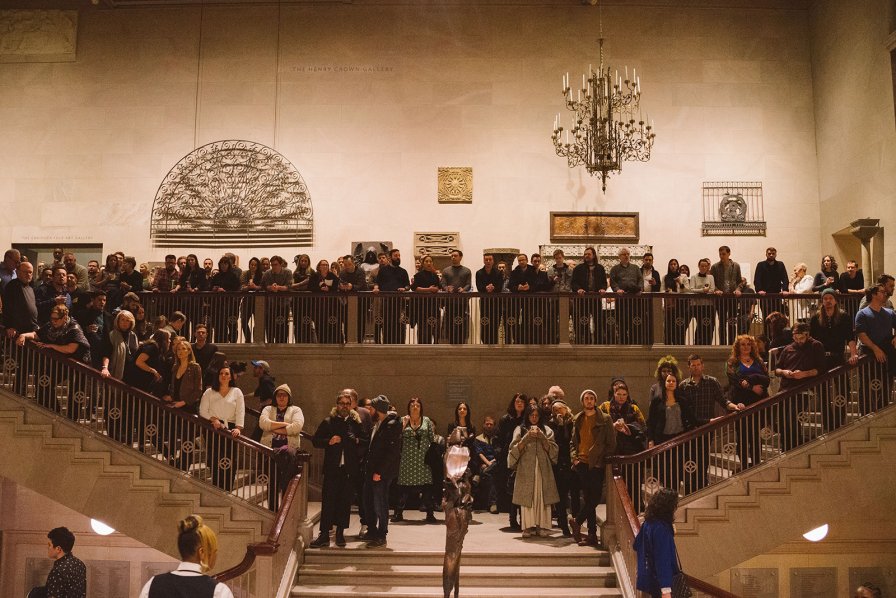On February 15-17, Pitchfork held the first installment of its new Midwinter festival at the Art Institute of Chicago. Over the course of three days, musicians performed in designated spaces throughout the museum, from large concert halls to intimate galleries. The real star of Midwinter, however, was history itself, though it was hidden behind a shroud of bass, strobe lights, and Heineken (as well as Tecate, for the more discerning). History lived, one way or another, in every performance: Mount Eerie sang about the past and the present in a distortion-soaked auditorium on Friday night, while Oneohtrix Point Never closed out the weekend with a live orchestration of music that blends ancient, Baroque, and postmodern ideas. “We love art!” Bradfox Cox yelled during Deerhunter’s deafening Saturday evening set. “Please turn up the vocals!” They then played thunderous renditions of “Helicopter” and “Desire Lines” only a few dozen meters away from paintings by Jackson Pollock and Mark Rothko.
What does it mean that Pitchfork’s Midwinter festival — whose extravagant and awkward ticketing structure has been well-criticized elsewhere — took place at the Art Institute of Chicago? The decision to have a heavily experimental music festival take place in a building that houses some of history’s most important artworks was, of course, quite deliberate. In fact, there was a component of the schedule dedicated exclusively to interactions between music and art, where composers like Midori Takada, Kaitlyn Aurelia Smith, and Visible Cloaks contributed new pieces based on specific artworks, their music played through well-placed, wireless Sonos speakers in the rooms housing those works. On that note, there were also pop-ups from live musicians in some of those galleries; on Friday evening, I was looking at a sculpture and listening to a new piece by Stars of the Lid when Phil Elverum showed up out of nowhere to perform a short, three-song Mount Eerie set for a surprised crowd of roughly 50 people.

From the Renaissance paintings to the works of modernism, many of the artworks at AIC were created out of a desire to break and change the world and its patterns; their painters and sculptors, working against convention, turned out objects intended to challenge viewers, addressing how they experienced art and thus forcing them to think about their lives in new ways. Today, much of the deeper meaning of these works and what they sought to point toward has been lost (or, rather, is mostly found in academic writing). We now know these works as they pop up in commercials and memes, as they’re seen on t-shirts and coffee mugs, as objects in music videos intending to demonstrate a musician’s wealth. Is there any way to access the truth of these articles today? And if so, can someone attending a music festival do it? Or can we at best hope that the music and the art will speak to each other and create new, unique situations for patrons?
“Thank you all for coming,” Bill Callahan said to an attentive audience on Friday night. “I know the ticket was not cheap.” I suppose there’s no getting around it: Midwinter’s cost can be astronomical. If one had showed up just to see Bill Callahan, it would have cost almost $100. People I talked to over the weekend happily paid that much to only see their favorite artists; by my estimation, if I hadn’t had a press pass, it would have cost around $400 to see the shows I saw, and I didn’t even go that hard. That said, if you could afford it, Midwinter was a truly unique experience that I found worth having. I mean, you basically can’t do something like this anywhere else in the world, at least to my knowledge.
For a festival, Midwinter provides a fairly relaxed environment. It’s easy to go there to see music and art and mostly be left alone — I rarely waited in lines or found myself adrift in a sea of people. You do get what you pay for here, and it’s nice. But if you want to have a really deep experience with the museum’s art, to really contemplate the meaning of the event, it’s your responsibility to put the pieces together — the art’s inherent “meaningfulness” is not expressly jammed down your throat by the festival’s curators. In fact, Midwinter’s execution was rather tasteful. It was almost entirely up to the attendees whether they see any art at all; one could theoretically get through this festival without having to look directly at a single painting. And, if I’m being honest, that’s more or less how I did it.

I’m not sure how useful it is to review individual shows, but I’ll mark a few highlights. Grouper was far and away my favorite set of the weekend — the intimate, dark, deep purple hall was a perfect way to experience Liz Harris’s music, which filled the space with thick, beautiful echoes and wafting vocal layers. It was magnificent. Likewise, Panda Bear offered a powerful set full of trippy visuals and rambunctious beats. On the lighter side, Bill Callahan’s solo set was a fantastic way to open the weekend, an expert blend of deadpan humor and pensive folk music. On the other side, I wasn’t crazy about Oneohtrix Point Never’s set, which had every reason to succeed, from the remarkable musicians involved to the spectacular source material (just putting it out there: Age Of was my favorite album of 2018). But in orchestrating this experimental electronic music for a live band, something felt lost in translation, the spaces between the sounds becoming more visible than I would’ve liked. An ultimately successful experiment, the performance was fun to watch and dramatically enticing, but it provided a sort of discordant listening experience. Maybe that’s not a bad thing. In fact, maybe that’s actually most appropriate for this festival.
When the doors were closed at the end of the weekend, the problems posed by the museum’s art remained. Did many of us end up seeing the art in a new light? What did Panda Bear’s music break, other than possibly my eardrums? The crashing percussion and explosive bass, all the biggest noises, did not break or transform the works in the museum — not really. A week later, the Art Institute of Chicago is still here. The paintings and sculptures are still here, and so are the sales booths and the gift shop and the members’ lounge. But the music is gone. Until next year.
More about: Bill Callahan, Deerhunter, Grouper, Kaitlyn Aurelia Smith, Midori Takada, Mount Eerie, Oneohrix Point Never, Panda Bear, Visible Cloaks



